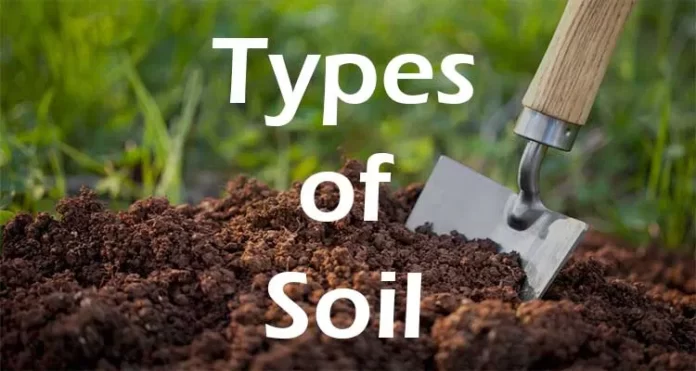भारत में प्रमुख मिट्टी के प्रकार – Major Soil Types in India (Gkduniya.in)
भारत में प्रमुख मिट्टी के प्रकार – Major Soil Types in India (Gkduniya.in):- Soil types are classified according to many more factors (colour, depth, pH, productivity, texture and process of formation).
Major Soil Types in India
1. Red Soil (लाल मिट्टी) :–
There are two broad classes of red soil
A. Allow material of red loam and concrete material with muddy structure.
B. Red clay with loose, permeable top soil and a high content of secondary concrete.
Generally, these soils are light textured with porous and friable formations and lack lime cobbles and free carbonates. They have neutral to acidic reactions and are deficient in nitrogen humus, phosphoric acid and lime.
2. Peat and marshy soil (पीट और दलदली मिट्टी):–
These soils are found in the coastal tract of Kerala, Orissa, Sunder bans region of West Bengal. When the vegetation growing in such wet places dies, it decomposes very slowly due to excessive wetting of the soil and, after many hundreds of years, a layer of partially decayed organic matter accumulates on the surface. Which gives rise to such peat and marshy soils. These are dark colored, heavy and highly acidic soils. When properly drained and fertilized, these soils produce a good crop of rice.
3. Laterite and Laterite Soil (लैटेराइट और लैटेराइट मिट्टी)
These soils are red to reddish yellow in color and are low in N, P, K, lime and magnesia. These soils form in situ under conditions of high rainfall with alternating dry and wet periods. Due to heavy rainfall, there is excessive leaching of soil colloids and silica, hence the soil is porous.
4. Saline and alkaline soils (लवणीय और क्षारीय मिट्टी)
These soils are found in areas with slightly higher rainfall than in desert areas. They show a white layer of calcium and magnesium and sodium salts on the surface.
5. Black soil (काली मिट्टी )
These are mostly clay soils and form deep cracks during the dry season. Lime accumulation is generally observed at varying depths. They are suitable for growing cotton. These soils lack nitrogen, phosphoric acid and organic matter but are rich in calcium, potash and magnesium.
6. Forest and hilly soils (वन और पहाड़ी मिट्टी)
These soils occur at high altitudes as well as at low altitudes, where there is sufficient rainfall to support the trees. These soils are very shallow, steep, rocky and infertile for the production of field crops. However, they serve a very useful purpose by supplying forest products such as wood and fuel.
7. Alluvial soil (जलोढ़ मिट्टी)
These soils occur along rivers and represent soil material deposited by rivers during floods. Generally, they are very productive soils but many are deficient in nitrogen, humus and phosphorus.
8. Desert soil (रेगिस्तानी मिट्टी)
These are mostly sandy soils that occur in tracks with low rainfall. They are well supplied with soluble salts but are low in nitrogen and organic matter and have a high pH value. These are productive and subject to wind erosion.
Soil Types by Depth (गहराई के अनुसार मिट्टी के प्रकार)
- Shallow soil (उथली मिट्टी)– Soil depth less than 22.5 cm. In such soils only shallow root crops are grown, eg. Paddy, Nagli.
- Medium deep soil (मध्यम गहरी मिट्टी) – Soil depth 22.5 to 45 cm In this type of soil medium deep rooted crops are grown. Sugarcane, banana, gram.
- Deep soil (गहरी मिट्टी) – The depth of the soil is more than 45 cm. Long and deep rooted crops are grown in this type of soil. Mango, Coconut.
www.GKDuniya.in will update many more new jobs and study materials and exam updates, keep Visiting and share our post of Gkduniya.in, So more people will get this. This content and notes are not related to www.GKDuniya.in and if you have any objection over this post, content, links, and notes, you can mail us at gkduniyacomplaintbox@gmail.com And you can follow and subscribe to other social platforms. All social site links in the subscribe tab and bottom of the page.
Important Links
| Particulars Official Links | Related Links |
| You-tube |
GKDuniya9 |
GKDuniya.in, IndiaDigitalHub |
|
GKDuniya.in |
|
| Another site visit |
Indiadigitalhub.com |
| Get new updates |
Click here |


